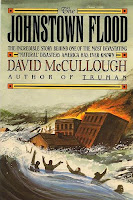As long as I can remember, I have been fascinated by the Johnstown Flood of 1889. It might have started when I discovered a book on my parent's bookshelf called The History of the Johnstown Flood by Willis Fletcher Johnson. I have no idea where the book came from, but it was published in 1889, and contains many photos, like the one above, and many very inaccurate stories. I was hooked! It wasn't until I was in my 30s, though, that I was actually able to make a trip to Johnstown.
There was so much I didn't know about the flood and why it happened, but after my trip to the Johnstown Flood Museum I knew a lot more. What I didn't learn at the museum I discovered in David McCullough's book, The Johnstown Flood. It offers a fascinating look at what lead to that momentous day, May 31, 1889.
In observance of the anniversary of the flood, here are some things I learned from my visit and David McCullough's book:
- Johnstown had been prone to flooding for many years, so when the heavy rains started people knew there could be flooding. But the residents of Johnstown were not prepared for the possibility of the dam at Conemaugh Lake, 14 miles away, bursting and sending a wave of water over 30 feet high to destroy their town.
- The dam had been built between 1838 to 1853 as part of the canal system that became obsolete in 1854.
- The South Fork Hunting and Fishing Club owned Conemaugh Lake and the dam at the time of the flood. The members of this club were the elite businessmen of their age. Most of them were from Pittsburgh. A few of its famous members were Henry Clay Frick, Andrew Mellon, and Andrew Carnegie.
- After the club purchased the lake and surrounding area, they made a few changes to the dam that were not improvements. They put screens across the spillways to keep the fish from escaping and they lowered the dam by several feet so that carriages could cross it. An earlier owner had removed the drainage pipes so that the lake could not be drained, and they were never reinstalled.
- The dam contained 20 million tons of water, which is about the same amount of water that goes over Niagara Falls in 36 minutes.
- A telegram was received in Johnstown sometime in the afternoon of May 31 that warned that the dam was likely to break. No one is sure when it was received and, unfortunately, not enough people actually saw it. The ones who did see it did not take it seriously, since there had been many false alarms over the years.
- The wave of water that hit Johnstown was 30 to 40 feet high and traveling at 40 miles per hour when it hit Johnstown, after hitting other small towns along the way. The dam broke sometime after 3 PM and hit Johnstown at 4:07 PM.
- More than 2,200 people died, including 99 entire families. More than 750 people were never identified and are buried in the Plot of the Unknown in Grandview Cemetery, Johnstown. There were bodies found as far away as Cincinnati. Bodies were still being discovered in 1911.
- The Johnstown Flood was the single largest one-day loss of civilian life in the United States before September 11, 2001.
- Clara Barton and the Red Cross arrived in the area on June 5, 1889 to help in the rescue and relief effort. This was the first major peacetime disaster relief effort for the organization.
- The flood was the biggest event of that era. Because of the coverage of newspapers, the world knew of the flood within days and donations started arriving from all over the world shortly after. The first relief train from Pittsburgh arrived on June 1.
- The South Fork Hunting and Fishing Club was never held legally responsible for the flood.
- Johnstown would again experience devastating floods in 1936 and 1977.
If you are interested in history, especially Pennsylvania history, make sure you get to the Johnstown Flood Museum and the Johnstown Flood Memorial to see first hand what happened there on May 31, 1889.
More Information:
The Johnstown Flood by David McCullough (1968)More Information:
Johnstown: The Day the Dam Broke by Richard O'Connor (1957)
Through The Johnstown Flood: By A Survivor by Rev. David J. Beale (1890)
DVDs:
Johnstown Flood (2003)






No comments:
Post a Comment